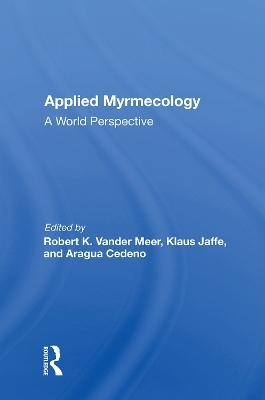
Applied Myrmecology
A World Perspective
Seiten
2019
CRC Press (Verlag)
978-0-367-01324-0 (ISBN)
CRC Press (Verlag)
978-0-367-01324-0 (ISBN)
- Titel z.Zt. nicht lieferbar
- Versandkostenfrei
- Auch auf Rechnung
- Artikel merken
This book brings together a picture of the systematics, reproduction, biology and control of pest ants, found in South America, Africa, Australia, India, Europe, and North America. It demonstrates that applied myrmecology has matured into a distinct scientific discipline.
Ants have always fascinated the nature observer. Reports from ancient Egypt and Mesopotamia indicate that ants interested humans long ago. Myrmecology as a science had its beginning in the last century with great naturalists like Andre, Darwin, Emery, Escherich, Fabre, Fields, Forel, Janet, Karawaiew, McCook, Mayr, Smith, Wasmann and Wheeler. They studied ants as an interesting biological phenomenon, with little thought of the possible beneficial or detrimental effects ants could have on human activities (see Wheeler 1910 as an example). When Europeans began colonizing the New World, serious ant problems occurred. The first reports of pest ants came from Spanish and Portuguese officials of the fifteenth and sixteenth centuries in Trinidad, The West Indies, Central America and South America. Leaf-cutting ants were blamed for making agricultural development almost impossible in many areas. These ants, Atta and Acromyrmex species, are undoubtedly the first ants identified as pests and may be considered to have initiated interest and research in applied myrmecology (Mariconi 1970).
Ants have always fascinated the nature observer. Reports from ancient Egypt and Mesopotamia indicate that ants interested humans long ago. Myrmecology as a science had its beginning in the last century with great naturalists like Andre, Darwin, Emery, Escherich, Fabre, Fields, Forel, Janet, Karawaiew, McCook, Mayr, Smith, Wasmann and Wheeler. They studied ants as an interesting biological phenomenon, with little thought of the possible beneficial or detrimental effects ants could have on human activities (see Wheeler 1910 as an example). When Europeans began colonizing the New World, serious ant problems occurred. The first reports of pest ants came from Spanish and Portuguese officials of the fifteenth and sixteenth centuries in Trinidad, The West Indies, Central America and South America. Leaf-cutting ants were blamed for making agricultural development almost impossible in many areas. These ants, Atta and Acromyrmex species, are undoubtedly the first ants identified as pests and may be considered to have initiated interest and research in applied myrmecology (Mariconi 1970).
Robert K. Vander Meer, Klaus Jaffe, Aragua Cedeno
Foreword /C.S.Lofgren -- Preface -- Acknowledgments -- ANT PESTS OF THE WORLD -- SYSTEMATICS AND MORPHOLOGY -- REPRODUCTION -- NATURAL HISTORY AND BIOLOGY -- BEHAVIORAL AND CHEMICAL ECOLOGY -- APPLIED ECOLOGY -- CONTROL -- List of Contributors -- Taxonomic Index -- Subject Index.
| Erscheinungsdatum | 16.09.2019 |
|---|---|
| Verlagsort | London |
| Sprache | englisch |
| Maße | 152 x 229 mm |
| Gewicht | 1569 g |
| Themenwelt | Schulbuch / Wörterbuch |
| Naturwissenschaften ► Biologie | |
| ISBN-10 | 0-367-01324-X / 036701324X |
| ISBN-13 | 978-0-367-01324-0 / 9780367013240 |
| Zustand | Neuware |
| Haben Sie eine Frage zum Produkt? |
Mehr entdecken
aus dem Bereich
aus dem Bereich
was Mikroben, Tiere und Pflanzen eint und wie sie uns ernähren
Buch | Softcover (2024)
Lenos (Verlag)
CHF 31,95
was wir alle wissen sollten
Buch | Softcover (2023)
Mitteldeutscher Verlag
CHF 33,55


